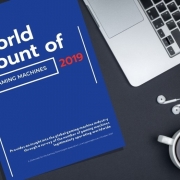CASHLESS ECONOMY IN AUSTRALIA
- Measured by the number of card transactions each year, Australia is supposed to be the sixth-most cashless society on earth. The Federal Government is at this very moment even considering outlawing transactions in the stuff over $10,000.
- Yet, despite that, we have more cash in circulation per capita than ever before. The RBA is even rolling out new banknotes and leading the charge globally to update our currency to make it safer and more accessible.
- While some predicted that cash would disappear from Australian shores as early as 2022, making us the first country in the region to go cashless, there’s plenty of reasons to believe cash is still as important as ever.
The unveiling of the new $20 note in Australia on last month was a fairly humble affair.
If there wasn’t any fanfare, perhaps there should have been. After all, the move is contrary to the expectation that the end for cash is nigh – and at the same time the government appears to be waging a war on it.
Prime Minister Scott Morrison and his government introduced legislation to parliament in September that could make it illegal for Australians to pay for purchases over $10,000 in cash. A senate committee is currently open to submissions from the community. The task recommended by the Black Economy Taskforce, with those who support it claiming the bill’s purpose is to crack down on illegitimate activity, from tax evasion to money laundering.
Tap and go has been around for years. New technology and payment companies are reducing the cost and time required to move money, and online shopping is forecast to explode.
Certainly, it appears that Australians are using cold hard cash less and less. In 2008, we used to go to the ATM 40 times per year on average, according to the RBA’s figures. A decade later, it was down to 25 times and declining. Over roughly the same period, the number of card transactions quintupled.
But despite predictions of us becoming cashless society by 2022, Australia is still flush with the stuff. In fact, the amount of cash in the Australian economy is near a 50-year per-capita high, according to the RBA, and its predominantly $50 and $100 bills that we’re clinging on to.
“For every Australian, there are currently around thirty $50 and fourteen $100 banknotes on issue,” Lowe explained at last year’s payment summit. “So there is an apparent paradox between the declining use of cash and the rising value of banknotes on issue.”
A recent technical error in Australia saw ATMs and EFTPOS machines unable to accept payment or distribute cash, leaving thousands around the country unable to use their money. A strong reminder that cash doesn’t require electricity and internet to function.
These are all obstacles flashy cards and electronic payments will need to deal with to complete their climb to the top of the payment world. According to Lowe, these competing types will need to improve their reliability, functionality, and transaction cost. Already there are new entrants into the market which are adding the competition required to improve these. So too the further adoption of open banking and new payment technology.
However Lowe, despite believing cash will become a niche payment option over time, still thinks there’s a place for the humble banknote in this modern world.
“While it is difficult to predict the future, I expect that banknotes will remain part of our payments system for some time to come,” he said.
CNN published an infographic in 2017 showing how major world economies were evolving towards cashless economies with Australia even then listed as almost cashless. To download click here >>> http://edition.cnn.com/2014/07/02/business/is-a-cashless-society-on-the-cards/index.html
Source: https://www.businessinsider.com.au/australia-cashless-society-cash-ban-card-payments-2019-10













